Kanji for Eye: 目 (me/(め)
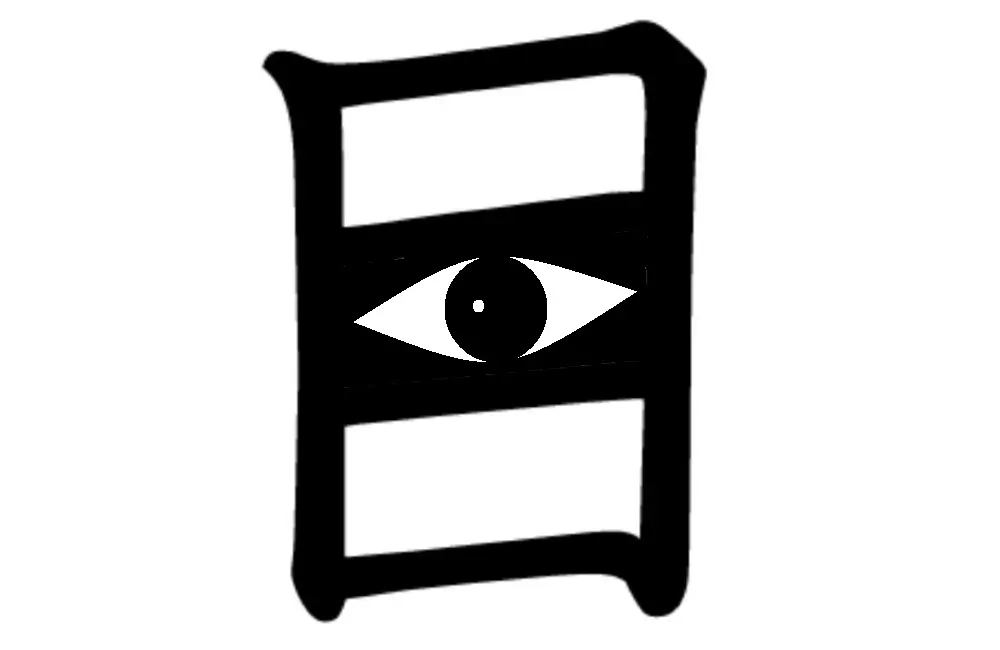
The Japanese kanji for “eye” is 目.
The kun’yomi (Japanese reading) pronunciations of the Kanji 目 are “me” or (め) “ma” (ま), and the on’yomi (Chinese reading) pronunciations of 目 are “moku “(モク) or “boku” (ボク).
The Kanji 行, for “eye”, appears in 1,450 Japanese names, and in that case, it is pronounced Sakan (さかん), sagan (さがん), sakka (さっか) or satsuka (さつか).
The Kanji 目 is constructed with 5 strokes, and it is a part of the JLPT N4 syllabus (please check the list of JLPT N4 Kanji). In Japanese schools, this Kanji is taught in grade 1.
Origin of the Shape 目
If we see the old shape of the Kanji 目 in the Oracle Bone Script, it shows as a rough sketch of an eye.
Let’s see the evolution of the shape of the eye’s Kanji from ancient times to the current:
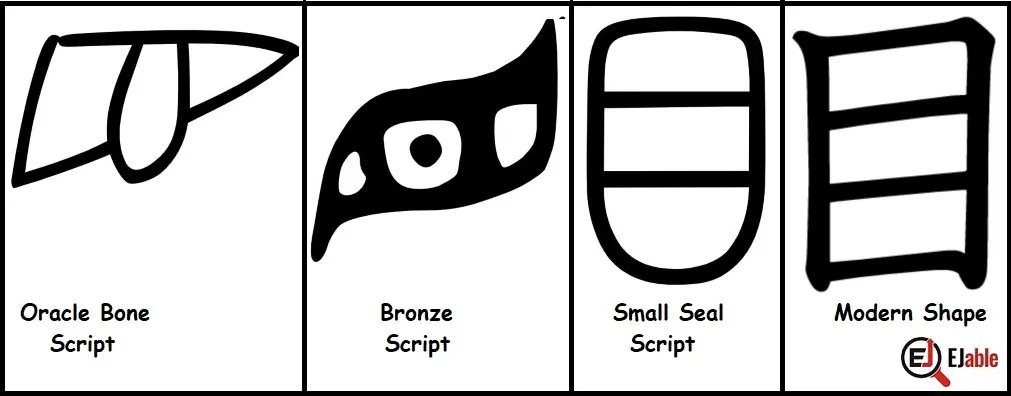

The above image shows the historical shape of 目 in Oracle Bone Script, Bronze inscription, small seal script, and how we write it in the present.
Mnemonic: How to Remember the Kanji for “eye” (目)
In a way, the kanji for the eye (目) is quite simple to remember. However, at first glance, beginners may wonder about its square shape and lack of resemblance with the shape of the eye.
However, if you remember some of the following simple rules for Kanji formations, it’s very easy to remember this kanji:
- Curved shapes and lines are made straighter in Kanji characters.
- Intersection points of curved lines are stretched to make them straight lines from points.
Therefore, the following representation of the kanji 目 explains the above principles visually to help you remember this kanji:
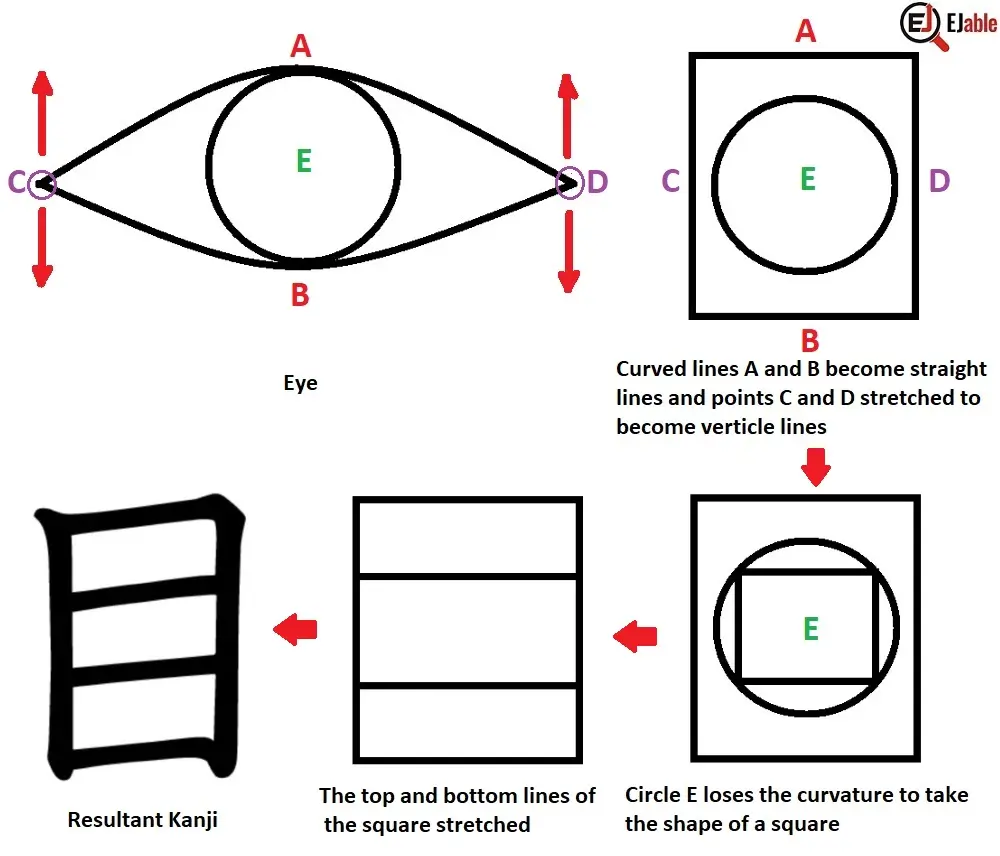

Stroke Order for the Kanji 目
The following illustrations show the order of the 6 strokes to write the Kanji 目:
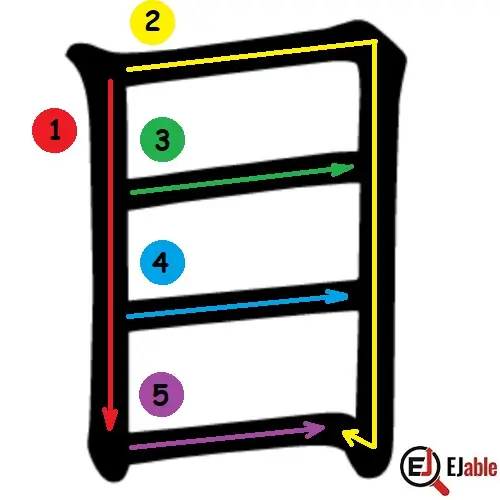

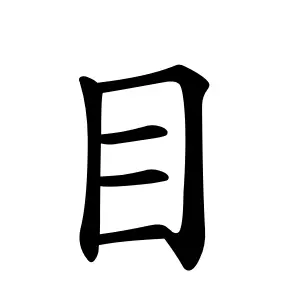

Kanji 目 as a Radical or Component
The Kanji 目 is used as a radical or component in 806 Kanji characters, out of which 138 are Jōyō (commonly used) Kanji.
In these other Kanji characters, 目 contributes meanings related to vision, seeing, or something related to the eye.
Examples of Kanji 目 as Radical or Component
Here are some examples of Kanji characters that include the 目 radical:
- 見: (み-る / mi-ru) to see, (み-える / mi-eru) to be seen; to appear, (み-せる / mi-seru) to show
- 買 (かう / ka-u): to buy
- 看 (かん / kan): To watch, to look after.
- 直: (チョク / Choku / ジキ / jiki) honest; direct, なお-す / nao-su) to correct; to repair, (なお-る / nao-ru) to be cured, (ただ-ちに / tada-chini) immediately
- 眠 (みん / min): To sleep.
- 眼 (がん / gan): Eyeball, eye.
- 眺 (ちょう / chō): To gaze, to look far.
- 眉 (び / bi): Eyebrow.
- 盲 (もう / mō): Blind.
- 直 (ちょく / choku): Straight, directly; implies seeing things clearly.
- 省 (せい / shō): To reflect on, to overlook.
- 相 (そう / sō): Mutual, appearance.
- 監 (かん / kan): To supervise, oversight.
- 員 (イン / in): employee
- 親: (おや / oya) parent; (した-しい / shita-shii) close, intimate; (した-しむ / shita-shimu) to befriend, grow close to
- 盾 (じゅん / jun): Shield; metaphorically relates to protecting like an eye watches out.
- 盛 (せい / sei): To prosper, to fill; visually related to the idea of something being full to the brim, under observation.
- 真 (しん / shin): True, reality; exactly.
- 睡 (すい / sui): To doze, to sleep.
- 盟 (めい / mei): Alliance, oath; conceptually involves witnessing or agreeing under observation.
Kanji 目 (Eye) in Compounded Words
The kanji 目 appears commonly in Japanese and forms part of many compound words. There are 377 Japanese words that begin with the Kanji 目, and it appears in 1214 words.
Examples of Kanji 目 in Compounded Kanji Characters
- 目的 (もくてき / mokuteki): Purpose, goal; refers to the object or aim one is “looking” towards.
- 目次 (もくじ / mokuji): Table of contents; the “list” of topics one “sees” in a document or book.
- 目覚め (めざめ / mezame): Awakening; the act of opening one’s “eyes” from sleep.
- 目立つ (めだつ / medatsu): To stand out; to be conspicuous as if catching the eye.
- 目安 (めやす / meyasu): Criterion, benchmark; a “mark” used for assessment or guidance.
- 目撃 (もくげき / mokugeki): Witness; the act of having “seen” an event occur.
- 目情 (もくじょう / mokujō): Situation, circumstances; the “conditions” one observes or notices.
- 目下 (もっか / mokka): Inferior, junior; literally “below the eyes,” indicating someone of lower status.
- 目薬 (めぐすり / megusuri): Eye drops; medicine applied directly to the “eyes.”
- 目玉 (めだま / medama): Eyeball; the spherical part of the eye.
- 目視 (もくし / mokushi): Visual inspection; checking something by “sight.”
- 目印 (めじるし / mejirushi) – Mark, sign; a visual “indicator” used to attract attention or signal something.
- 白目 (しろめ / shirome): Whites of the eyes; referring to the white part surrounding the iris.
- 目録 (もくろく / mokuroku): Catalog, list; a detailed “list” for viewers to “see.”
- 目分量 (めぶんりょう / mebunryō): Estimation by eye; measuring or judging something visually without precise tools.
These compound words demonstrate the broad application of eye’s kanji 目 in expressing concepts related to sight, observation, and aspects that are visually noteworthy or significant.
Note: Check other Kanji characters on the page “How to Remember Kanji“.


A long-term ex-pat in Japan, Himanshu comes with an IT background in SAP consulting, IT Business Development, and then running the country operations of an IT consulting multinational. Himanshu is the co-founder and Managing Director of ReachExt K.K. and EJable.com. He is also an Advisory Board Member of a Silicon Valley AI/IoT startup.

